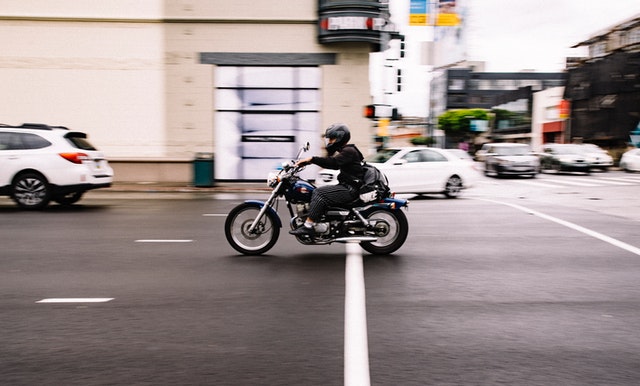Your street-biased motorcycle is perfect for a ride. It has the correct tyre pressure and all systems seem to be functioning as it should.
You are enjoying your ride and cruising along the motorway comfortably. You hit a pothole and then you feel the motorcycle handling feels a little odd.
It seems to be pulling on one side. So, what has happened in a blink of an eye and what went wrong?
A motorcycle that’s pulling to one side is a sign of a bigger problem that shouldn’t be ignored.
In its working lifespan, it doesn’t happen naturally and hence it is safe to assume there’s some cause behind this.
Besides spoiling the ride, a motorcycle suddenly pulling to one side can make a rider jittery when it comes to balancing the machine.
In real-time mostly, the problem isn’t that evident in straight line riding but a rider can experience it while taking a turn or when manoeuvring inclines.
This can be a potential dangerous situation for the novice rider who may not know what to do under such circumstances. It can also become a safety problem.
The machine pulling to one side suggests an alignment problem which means the wheels are not in a straight line.
Alignment problems in a motorcycle can occur as a result of a structural fault of a weak component due to stress or impact damage. It can also be caused by incorrect fitments of parts.
Some problems are easy to find and can be fixed quickly. In some cases no cost is involved and that’s a great relief for the rider!
Serious problems will need expert help and special tools. It can be expensive when it comes to repairs or replacements of parts.
The concept of balances and checks is quite appropriate out here.
Let’s try and understand each of the trouble areas and find their respective solutions.
Where to begin?
The core focus area should be around the architecture of suspension and chassis and components that are associated with it.
There are some engineering parameters in the motorcycle’s structure that are universal.
Take the relationship between the front wheel and handlebars — irrespective of machine type and how high the handlebars are, they are always perpendicular to each other and maintain a perfect 90-degree angle.
These non-negotiable measurements are key to the neutral handling of the machine and when they are distorted, the tell-tale symptoms arise.
Damage assessment
Potholes don’t come with a warning. Speed breakers do. Rider awareness needs to be high and a good and experienced rider will anticipate road conditions and ride safely.
Hitting a nasty pothole is the last thing you would want to encounter, especially at speeds.
At speeds, the impact can be devastating to the motorcycle and in some cases catastrophic for both man or machine.
A quick thinking evasive manoeuvre may soften the blow.
Usually, hitting a shallow pothole at speed will not have any measurable impact apart from a wobble.
If the motorcycle has good tyres and strong rims, it should be able to counter the impact.
Even if the rider has spotted the uneven surface ahead, he may or may not have enough time to avoid it. However, hitting a deep pothole at speed can result in a different scenario.
Riders may experience a wobble, uneasy steering, and vibration besides the experience of the motorcycle pulling to one side — left or right.
Riding with a motorcycle that’s pulling on one side is strenuous for the rider, his/her shoulders in particular as they have to counter the pulling stress with their posture.
Parts that get impacted

The first item that bears the brunt of the impact is the wheel. Usually, motorcycles are endowed with either steel rims with spokes or made of aluminium alloys.
Aluminium alloys are shod with tubeless tyres but it may not be the case with steel rims that get tubes.
Aluminium alloys are usually molten cast or CNC billeted (in very expensive machines) while steel rims are cold rolled from plates.
As a result of their inherent metal structure, steel and aluminium rims will react somewhat differently to impact.
The rider has to be very careful and remain alert when tackling unwanted situations.
Metal fatigue may also determine the extent of damage to the wheels or other parts in the motorcycle’s set-up.
In the worst case, a poor quality alloy rim may shatter to pieces and throw off the rider. A good quality alloy may crack, buckle or get bent.
Damages caused due to slides
The last thing a rider would not want to do is skid at high speeds especially during poor weather conditions like rain, snow or low traction surfaces caused by black ice or unlikely oil spills.
Without warning, the motorcycle will go out of the rider’s control and flip on one side, with its momentum letting it drag for a few metres depending on the speed it was travelling.
Panic braking by the rider who has not been able to judge riding conditions will certainly cause the motorcycle to crash or flip.
Apart from friction related surface damages to mainly the exhaust cans, the bulk of the impact is borne by the handlebar, triple-tee and front fork.
In severe cases of impact, the handlebar can shear out from its mounting.
Bent fork tubes will severely hamper the motorcycle’s neutral handling and it’s evident with the motorcycle pulling.
The other major problem that can arise is related to front end — damages to the neck of the frame/chassis. If this is bent, then you are looking at an expensive repair bill and in the worst case, a write-off.
An experienced and very skilled technician with proper tools and jigs may be able to repair or restore the damaged frame, but this is time consuming and expensive. Plus, there’s no guarantee that the job will be 100% accurate or perfect to factory specs.

Bike drop or shunt
Dropping a heavy motorcycle has its repercussions. This may happen during loading or unloading operations. Improper anchoring can stretch the forks out of its normal tolerance range.
On the move, riders can also drop a motorcycle during slow or sharp u-turn manoeuvres.
The worst that can happen to the motorcycle when it is shunted or if there’s a front end hit is bent forks along with a triple tree.
Front forks host the front wheel and the triple tree ensures its position and working relationship with the handlebar. The fork tubes can be vulnerable to very hard impacts.
Out of line wheels are easy to spot when the motorcycle is positioned vertically.
A bent fork can be identified using the following technique:
- Take off the mudguard, detach brake hose clip.
- Remove disc brake caliper assembly (leave it on the disc)
- At a time loosen all fork bolts and axle.
- Rotate the fork tube. If it is bent the bottom holder will appear to slide in or out on the axle. If the fork tube is OK, there will be no movement.
- Tighten bolts and repeat the process on the other side.
Improper fork assembly
In the hands of an inexperienced mechanic, a refurbished fork assembly may highlight trouble spots if not bolted-on correctly.
Although, in most circumstances, the top clamp does not disturb the alignment of the bike, it’s the middle part of the assembly, that is the lower part of the triple tree that holds the key to perfect balance.
Bent Triple Tree
In a high impact collision or shunt will bend the Triple Tree which in turn will upset the wheel alignment
A bent triple tree can be identified using the following technique:
- Remove all steering components till you just have the base and stem
- Place the unit vertically on a thick glass sheet and see how it sits.
- If the triple-tree is bent it will show up as a wobble.
- DIY repair is possible with proper tools and some muscle power
- Check the bearing cup and cones before reassembly. It may require replacement.
Incorrect fitting of tyre on rim
Bead lock of a tyre on a rim is very important as even a small deviation can disturb the wheel balance besides encouraging slow leaks in tubeless tyre set-ups.
When replacing a tyre always check for the tyre rotation symbol — an arrow on the sidewall. If it’s fitted the wrong way, it will cause the motorcycle to wobble and have an impact on the axle and bearings.
The most common problem that surfaces after a new tyre has been fitted is that the beads may not lock properly to the rim.
This aspect needs to be fixed before reuse.
A bent swing arm
As a key structural part of the chassis designed to handle suspension duties can show signs of wear and tear over time. Worn out silent block bushes if not periodically checked will cause the swing arm to wobble and impact straight line performance besides causing the motorcycle to pull.
The easiest way to determine worn out bushes is to prop the machine up on a stand so that the rear wheel is clear from the ground. Tugging the wheel sideways will give an indication of the play of the bushes. Replace them with new ones if there are signs of side play.
Improperly laced wire wheel
This can be a result of oversight by the technician who may miscalculate the torque requirements and axle position.
Actually, incorrectly tensioned spokes can distort the shape of the rim and misalign it. If this happens, the motorcycle fitted with such a wheel will show signs of dragging. This is a quick fix by an experienced wheel lacing technician.
Rear chain adjustment
It’s quite possible that due to oversight, the rear wheel axle may lose its neutral position. This can happen when the chain adjusters are not equally tightened. The chain will make stress noises if the axle hasn’t been positioned in the correct position and secured.
All motorcycle swing arms have identical guide points on both sides for helping to position the axle correctly.
The axle has to be positioned at equal distance for perfect balance. A loose axle lock nut can also be responsible for the axle to get misdirected.
Solution
A fixable solution will depend on the extent of damage to the wheels.
Steel rims are easy to repair as they can be welded, re-laced and balanced.
Alloys with light damage can be repaired and balanced. If bent or small cracks are evident, they can be welded and repaired by a specialist. For damaged alloys, it is usually advised to have them replaced with new ones.
Avoid refurbished wheel replacements, if possible.
